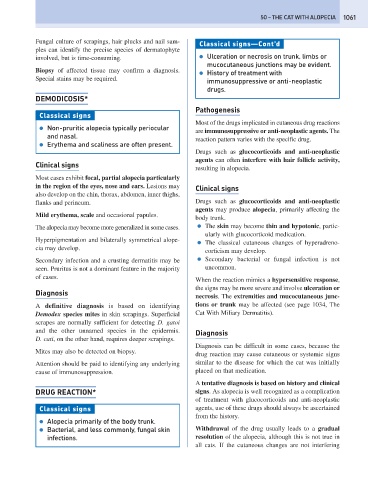Page 1069 - Problem-Based Feline Medicine
P. 1069
50 – THE CAT WITH ALOPECIA 1061
Fungal culture of scrapings, hair plucks and nail sam-
Classical signs—Cont’d
ples can identify the precise species of dermatophyte
involved, but is time-consuming. ● Ulceration or necrosis on trunk, limbs or
mucocutaneous junctions may be evident.
Biopsy of affected tissue may confirm a diagnosis.
● History of treatment with
Special stains may be required.
immunosuppressive or anti-neoplastic
drugs.
DEMODICOSIS*
Pathogenesis
Classical signs
Most of the drugs implicated in cutaneous drug reactions
● Non-pruritic alopecia typically periocular
are immunosuppressive or anti-neoplastic agents. The
and nasal.
reaction pattern varies with the specific drug.
● Erythema and scaliness are often present.
Drugs such as glucocorticoids and anti-neoplastic
agents can often interfere with hair follicle activity,
Clinical signs
resulting in alopecia.
Most cases exhibit focal, partial alopecia particularly
in the region of the eyes, nose and ears. Lesions may Clinical signs
also develop on the chin, thorax, abdomen, inner thighs,
flanks and perineum. Drugs such as glucocorticoids and anti-neoplastic
agents may produce alopecia, primarily affecting the
Mild erythema, scale and occasional papules.
body trunk.
The alopecia may become more generalized in some cases. ● The skin may become thin and hypotonic, partic-
ularly with glucocorticoid medication.
Hyperpigmentation and bilaterally symmetrical alope-
● The classical cutaneous changes of hyperadreno-
cia may develop.
corticism may develop.
Secondary infection and a crusting dermatitis may be ● Secondary bacterial or fungal infection is not
seen. Pruritus is not a dominant feature in the majority uncommon.
of cases.
When the reaction mimics a hypersensitive response,
the signs may be more severe and involve ulceration or
Diagnosis
necrosis. The extremities and mucocutaneous junc-
A definitive diagnosis is based on identifying tions or trunk may be affected (see page 1034, The
Demodex species mites in skin scrapings. Superficial Cat With Miliary Dermatitis).
scrapes are normally sufficient for detecting D. gatoi
and the other unnamed species in the epidermis. Diagnosis
D. cati, on the other hand, requires deeper scrapings.
Diagnosis can be difficult in some cases, because the
Mites may also be detected on biopsy.
drug reaction may cause cutaneous or systemic signs
Attention should be paid to identifying any underlying similar to the disease for which the cat was initially
cause of immunosuppression. placed on that medication.
A tentative diagnosis is based on history and clinical
DRUG REACTION* signs. As alopecia is well recognized as a complication
of treatment with glucocorticoids and anti-neoplastic
Classical signs agents, use of these drugs should always be ascertained
from the history.
● Alopecia primarily of the body trunk.
● Bacterial, and less commonly, fungal skin Withdrawal of the drug usually leads to a gradual
infections. resolution of the alopecia, although this is not true in
all cats. If the cutaneous changes are not interfering

